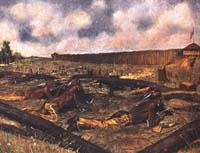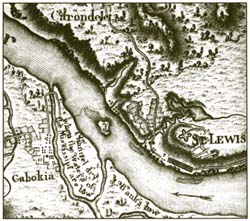
 |
The British (1763-1778)
American Indian forces under Chief Pontiac laying siege to Fort Detroit during the 1763 rebellion against British administration of the Great Lakes region. (oil on canvas by Frederic Remington) |
[W]e ask you [Lieutenant John Ross, British Army] to leave here as quickly as you can, to rejoin your chief whom you can tell that the sentiment of the Illinois, like that of all their brothers, is to make war on you if you wish to come on our lands. Get out, move on as quickly as possible and tell your chief all you have heard, that we are the children of the French and that they are the only ones we want among us. Tell him that these lands are ours and no one claims them, not even other red men. (Tamarois, Kaskaskia Chief, at Fort de Chartres, 1765)![]()
Great Britain took possession of the Illinois Country and other lands east of the Mississippi River when it signed the Treaty of Paris in 1763. However, an Ottawa chief named Pontiac led a revolt against the British that began in the spring of that same year. Pontiac objected when the British cut off vital supplies of gunpowder and ammunition needed by the Indians for hunting. He was also concerned by indications that the British planned to make way for the westward expansion of white settlement by pushing the Indians off of their land. Pontiac organized war parties of Kickapoo, Miami, Ojibway, Ottawa, Peoria, Potawatomi, Seneca, Wea, and Wyandot Indians, which successfully attacked nine of the eleven British forts in the Great Lakes region during the spring and summer of 1763. However, the British turned away long sieges at Fort Detroit (Michigan) and Fort Pitt (Pennsylvania), and Pontiac's rebellion ended with the approach of winter in the same year that it began.
The Kaskaskia and Peoria tribes had been allies of the French for many generations, and they resisted British takeover of the Illinois Country for two years following the end of Pontiac's war. British troops made several unsuccessful attempts to reach Fort de Chartres during this period, and it was not until October of 1765 that Captain Thomas Sterling finally arrived at the fort and took command from the French commandant, Captain Louis St. Ange de Bellerive.
![]()
Map of the Mississippi River showing St. Louis and Cahokia in 1796. (detail from "A map of the Country of the Illinois" by General George H. V. Collot, based on his voyage to North American in 1796)
After the transfer of power at Fort de Chartres (which the British renamed Fort Cavendish), St. Ange and many other French colonists crossed the Mississippi River into Spanish territory to reside in the newly formed village of St. Louis. The French emigrants were joined by most of the Illinois Indians, who established their own villages south of St. Louis. However, some Illinois of the Kaskaskia and Peoria tribes continued to live on the east side of the river at the villages of Kaskaskia and Cahokia.![]()
|
|
Copyright © 2000 Illinois State Museum
